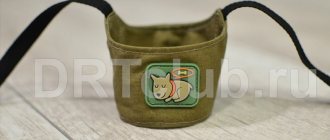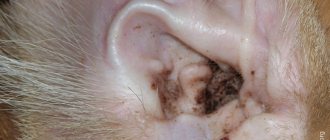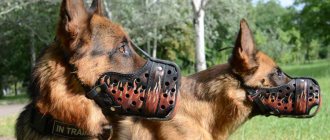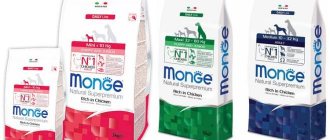Responsible future owners often think about whether their dog needs a muzzle. And immediately after purchasing an animal they realize that they really need it. It’s just that some will use it every day, while others will use it a couple of times a year: at a dog show and at the veterinarian. It is important to determine which breeds should be in it constantly, and which in certain cases. After a person has decided which dogs need a muzzle, it is necessary to study the information and find out which muzzle is best for this particular breed.
Muzzle law
Today there are a number of laws and acts (Federal Law “On the Responsible Treatment of Animals” dated December 27, 2022, Resolution No. 974 dated July 29, 2019), which together give the following picture:
- There are 12 dog breeds that are a priori considered cruel and capable of aggressive behavior. Such fanged ones must always be limited.
- In certain places and during certain events (exhibition, store, transport) absolutely everyone is required to be “in check”.
- Also, do not forget about the distribution of breeds into large and small. The boundary between these two concepts is weight. So, if your pet is heavier than five kilograms, do not forget to buy a muzzle.
- And remember that only the owner bears full responsibility for the dog’s behavior: if he shits - remove it, causes an accident - finance repairs, rushes, bites - pay for treatment and a fine.
Harness
The purpose of the harness is the same as that of a leash and collar. Those. The harness provides control over the dog's behavior.
Many pug owners prefer a harness over a leash and collar because they are confident that their pugs feel at ease in this equipment.
A harness is a strap that goes around the chest and passes between the front legs, i.e. in this case the neck is free.
Veterinarians recommend the use of harnesses for dogs with health problems in the neck area.
If your pug is a show exhibitor, you should not wear a harness often, as it may change the dog's gait.
The quality of the material that was used to make the harness is essential: it needs to be light, reliable and comfortable for both the pug and the dog’s owner.
Types of muzzles for dogs
Leather muzzle
This type of product has two options: actual leather and leather mesh. They have some differences, so let's look at each one separately.
1. Leather muzzle
This is a closed muzzle for dogs. It looks somewhat intimidating, just as muzzles should look. A wide strip of leather seems to surround the mouth; in addition, a leather insert in the front completely eliminates the possibility of a bite. This muzzle is needed for the dog so that it cannot harm people or other animals. When choosing this muzzle, you need to be careful, as it may be unsafe for the dog. During the warm season it will be very hot, and to regulate body temperature the dog must be able to open its mouth wide and hang out its tongue. Air access is also very important, otherwise the dog may suffer heatstroke and die.
Closed leather muzzles reduce oxygen supply and cannot be used in hot weather or during physical activity.
The good thing about this type is that, unlike plastic or metal, it is quite soft. When hitting a person with acceleration, another animal will not cause injury to either the one it is wearing or the one who was in its path. A definite disadvantage is getting wet and losing shape. Physiological secretions from the mouth and nose, dew, water and snow make the skin wet. Because of this, it subsequently becomes tanned and, as it were, dries out, taking on a not entirely natural shape. And if you put a muzzle on the dog the next time, then after a while the material will take on the correct shape. But still, the animal will experience discomfort at first. To buy a leather muzzle, you will have to spend a significant amount.
2. Muzzle – leather mesh
This type is more convenient for the animal. High-quality material, good fit and most importantly - sufficient ventilation. Just like the previous one, it tans after meeting liquids, but then returns to the required shape. The price is half the price of a regular leather one, since much less material is used in it. When purchasing a muzzle, you need to pay special attention to the details. Each leather strip is attached to the rest using small metal rivets. If they are of poor quality and quickly break off, the dog removes the muzzle or can simply stick out its mouth. This product has to be replaced approximately once a year due to wear and tear.
We advise you to read: How to stop a dog from shitting at home
A clear disadvantage of leather muzzles in general is the difficulty in caring for the material. It is difficult to wash and clean, and due to moisture and dirt it becomes tan and cracks.
You need to choose a leather muzzle so that the dog is safe in it and does not experience excessive discomfort. She was definitely able to open her mouth in it and breathe, sticking out her tongue, that is, the muzzle should under no circumstances tightly clasp the dog’s mouth. The nose should not rest against the base of the muzzle.
Be sure to gradually accustom your dog to the muzzle.
Plastic muzzle
This type of muzzle is used to prevent the dog from picking up food from the ground.
The base of the muzzle from the selection is usually almost blind, has only small slits, while the main part is a large mesh. Thanks to this, even the most dexterous dogs cannot push food found on the ground into the muzzle.
It is the plastic muzzle that is the most budget-friendly. On average, its price is 1/5 of the cost of a large leather muzzle. It is well ventilated, does not fall off, protects others from bites, while allowing you to breathe freely.
These muzzles are most often black or beige. Sold in many stores, it is important to choose the right size.
The problem can be that, after playing too much, the dog can scratch the bridge of his nose on the edges of the plastic mesh of the muzzle. However, now many manufacturers solve this problem by making the edges rounded in the nose area.
Another downside is that the plastic may crack over time.
And yet, a plastic muzzle is the best choice for walking; it is easy to wash, it does not retain odor, its price is not too high, and the dog feels comfortable in it after training.
It, like other muzzles, must be selected so as to give the dog the opportunity to open its mouth and breathe by sticking out its tongue.
Nylon (cloth) muzzle
These muzzles are also called medical or veterinary. The bottom line is that a nylon muzzle for a large or small dog is not designed for long-term wearing, but as a temporary measure, say, a visit to the veterinarian. Using a fabric muzzle, the owner secures the animal's mouth to protect the doctor. The product is small. Consists of a piece of fabric that fits tightly only part of the muzzle. And, of course, straps behind the head. The undoubted advantage of a rag muzzle is free access to the nose, ears, and eyes, if necessary for treatment purposes. It is very convenient that this product can have two variations:
- Fixed size. There is no way to buy one like this without trying it on in a store.
- Velcro for free resizing. This option is suitable for an owner who keeps several dogs of different breeds and sizes. The main thing is to understand how to properly put a muzzle on a dog; videos from the Internet can tell beginners how to do this.
Such a muzzle should never be used during normal walks, especially in the warm season.
Metal mesh muzzle
A metal muzzle is the strongest, highest quality and most practical to use. It is easy to predict who is wearing this type of product. These are large shepherd dogs (German, Caucasian), wolfhounds, great Danes and other large dogs. This is not exactly a muzzle for a beagle or a dachshund, although such options are acceptable. The price of the product will be significant. But you can use it indefinitely. Among the poles we will name the following: protection of others from bites, wear resistance of the material. Among the disadvantages: the possibility of injury and harm to others during activity, in some cases, the nose, lips and tongue sticking to the metal in the cold. Naturally, it has several varieties.
- With leather insert. Quite a convenient option. It fits well and is quite reliable. The disadvantages include freezing to the material in winter if the metal is not treated with paint, and hardening of the leather cover from exposure to water.
- Made of rubberized metal. A more ventilated version, chafing is possible, but no more than in all other cases.
We advise you to read: Fighting Dog Breeds
Such muzzles are most often used to protect others and to train the dog’s security qualities when working with a trainer.
Loop muzzle (halter)
A halter or halti is legally a muzzle. That is, you can visit those institutions and events where this dog accessory is necessary with a nylon tape around the mouth. But in fact, this training muzzle does not perform the classic functions of a muzzle. This is more of a collar for very large and heavy dogs, since the leash is attached to the halter ring located under the dog's muzzle. Like a bridle for a horse, only a halter will turn the dog's head when jerking. Thus, it allows you to keep even a very large dog on a leash if it decides to run off somewhere. Often used with dogs that are higher than a person's center of gravity, such as Great Danes.
It is very important to be careful with this type of corrective equipment, since the dog can injure the cervical vertebrae when jerking.
Carrying
For long-distance travel (on a train, plane, car), the animal is placed in a portable device. The carrier is a closed plastic container or bag. The dog feels calmer and more comfortable in it.
Carrying bags, backpacks and boxes are available for sale. The most practical option is a house bag. The mini-kennel can be used not only during trips, but also as a permanent sleeping place for your pet.
In accordance with the dimensions, a plastic container (size No. 3) is recommended for a pug. It is intended for small animals weighing 5-18 kg. Carrying size 60*40*39 cm. Box weight approximately 4 kg. The container is equipped with one handle. According to EU rules, to travel abroad, the carrier must be closed with a metal door with latches (video author TECTTB).
Which muzzle to choose
With a wide range of options and styles, there is always one that your pet needs. Choosing a muzzle for a dog is an important point, so you need to consider:
- Purpose of purchase. The most important criterion. If your Labrador retrieves food from the ground and you buy him a metal mesh, he will quickly learn to push the pieces of food he finds through the mesh, and the muzzle will not serve its purpose. If your task is to walk your dog in a muzzle all the time, and you purchase a nylon veterinary muzzle, then you may soon need a veterinarian, because such a muzzle in the heat and during physical exertion can lead to hyperthermia and death of the animal. Be careful.
- Animal size. The choice depends on height, weight, breed. Agree, a muzzle for small dogs and a muzzle for a Labrador to prevent picking up litter will be noticeably different. For large breeds, leather or metal muzzles are more often chosen, while for children - leather mesh or plastic. The main thing is that the muzzle meets your goals, otherwise it will not make sense.
- His temperament and habits. Definitely the most important criterion. If the dog constantly digs up dirt, snow, dewy grass, moss, etc., the skin will quickly become unusable. If he constantly runs and knocks people down, crashes into trees, the plastic will break, the iron will withstand the blow, but both options will be extremely painful.
- Price policy. Leather and metal are more expensive, plastic and fabric are cheaper. The main criterion is the purpose of the purchase.
- Personal preferences. If something seems beautiful to you, you can choose different types within the desired model.
How to choose the muzzle size
Before you put a muzzle on your dog, you need to decide on the size. The easiest option is to come to the store with your pet and try everything on. It is important to remember five conditions.
- Fixation behind the head under the ears. It should be fastened slightly above the collar, perhaps attached to it with a carabiner.
- Strap on the bridge of the nose. For dogs that often remove the muzzle themselves, it is better to choose a model that has two straps on the sides and one that goes between the dog's eyes.
- Below the eyes at a sufficient distance. When running and jumping, the animal may hit or scratch the eyeball with its muzzle - this should not be allowed. Plus, there is banal discomfort if the world is partially closed from view.
- The ability to breathe fully. When trying on the product, check that the dog can calmly open his mouth and stick out his tongue. Only in this way will there be sufficient cooling and oxygen supply to the animal’s body during activity.
- Seams. To avoid abrasions and injuries, check each connection. Do not expose your pet to pain.
We advise you to read: Can you get infected from a dog?
If it is impossible to be present during the fitting, measure the face of your four-legged friend. Based on your measurements, a pet store employee will show you how to measure a dog muzzle and choose the most suitable one. You will need a ruler and a soft measuring tape. The following values should appear on the sheet:
- distance from the point between the bottom line of the eyes to the top of the nose
- girth of the mouth two centimeters below the eyes (don’t forget to leave an allowance so that the dog in the muzzle can open his mouth freely)
- the distance between the bottom line of the dog's eyes and the point on the back of the head, directly opposite the nose
- neck circumference under the ears; the first four positions are measured with a tape
- nose width - measurement is taken with a regular ruler at the widest point of the mouth
- the height of the mouth with the mouth open is also a ruler.
This way you can choose the right muzzle for your dog.
Furminator
Pugs are characterized by strong wool shedding during the molting period. To shorten this period as much as possible and effectively remove dead fibers, use a furminator. It is a comb or comb, similar to a miniature rake. The teeth are attached to the handle. They collect fallen lint and at the same time allow stable top coat hair to pass through without damage.
Dog handlers advise brushing your pug from the top of its head to the base of its tail. Moving against hair growth will damage the coat.
Using a furminator, all dead fur is collected in 1-2 times. According to reviews from breeders, a medium-sized furminator designed for short-haired dogs of small breeds is best suited for pugs.
What to do if your dog takes off its muzzle
Like humans, animals sometimes have difficulty getting used to new circumstances or things. Imagine that you want to put glasses on your child, he does not understand what they are and why, and will take them off again and again.
To prevent your dog from taking off his muzzle, it is important to teach him not to be afraid and not to pay attention to this accessory. Use these tips:
- Don't let him play with him, let him know that this is not a toy. After use, keep it out of reach.
- Start working from home. Place a treat inside and offer to take out the treat. Do this many times until your dog starts sticking his muzzle in with pleasure.
- When the dog begins to put its muzzle inside on its own, fasten the straps and feed pieces of treats through the holes in the muzzle. Then we remove the muzzle and stop giving treats. We do this exercise many times so that the dog understands that the treat appears only when the muzzle is on.
- The duration of all exercises starts from a few seconds and gradually reaches several minutes. There is no need to overwork your dog with exercise.
- Associate with pleasant moments. Muzzle = treat.
- Now we go outside. We invite the dog to put his muzzle on the muzzle, then we fasten the belts and go for a walk. We periodically feed the dog treats at those moments when he behaves calmly and does not try to remove the muzzle.
- If you see an attempt to get rid of the muzzle, distract the dog with a toy or action.
- If you are unable to train your dog to wear a muzzle on your own, watch training videos about training using positive reinforcement or use the services of a trainer.
Photo gallery
Sometimes you have to put a muzzle on your pet, regardless of its breed, size and character. Let's see how your pet will look in this “no muzzle” dog accessory.










